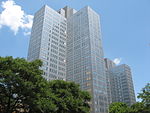Fort Pitt (Pennsylvania)
1761 establishments in PennsylvaniaAmerican Revolutionary War fortsBritish forts in the United StatesColonial forts in PennsylvaniaForts in Pennsylvania ... and 5 more
French and Indian War fortsGovernment buildings completed in 1761History of PittsburghInfrastructure completed in 1761Pontiac's War

Fort Pitt was a fort built by British forces between 1759 and 1761 during the French and Indian War at the confluence of the Monongahela and Allegheny rivers, where the Ohio River is formed in western Pennsylvania (modern day Pittsburgh). It was near (but not directly on) the site of Fort Duquesne, a French colonial fort built in 1754 as tensions increased between Great Britain and France in both Europe and North America. The French destroyed Fort Duquesne in 1758 when they retreated under British attack. British colonial protection of this area ultimately led to the development of Pittsburgh and Allegheny County, Pennsylvania by British-American colonists and immigrants.
Excerpt from the Wikipedia article Fort Pitt (Pennsylvania) (License: CC BY-SA 3.0, Authors, Images).Fort Pitt (Pennsylvania)
I 279, Pittsburgh
Geographical coordinates (GPS) Address Nearby Places Show on map
Geographical coordinates (GPS)
| Latitude | Longitude |
|---|---|
| N 40.4411 ° | E -80.009 ° |
Address
Portal Bridge
I 279
15222 Pittsburgh
Pennsylvania, United States
Open on Google Maps









